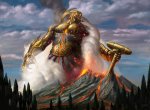Customising Cleric Domains II: Purphoros, God of Forge, Fire, and the Restless Earth
Sometimes you have a domain that can work for a specific god but it doesn't quite fit. In the case of Purphoros, the Light could easily be his domain of choice but Purphoros is a god of the forge, the earth, and fire. His clerics don't stand at the back of adventuring party casting spells, they get into the think of battle and use the gifts of their god to destroy their enemies.
The following is the domain of Purphoros, a god that is an embodiment of red mana from the Plane of Theros in Magic the Gathering. The description of his domains, signature item, personality, and worship are taken from the Planeswalker's Guide to Theros, part 1.
PURPHOROS
 Domains
Domains: Purphoros is the god of the forge, the restless earth, and fire. He rules the raw creative force of heat and energy that fills the souls of sentient beings. His energy emerges as chaos, something to be harnessed and shaped by labour and passion. For this reason, Purphoros is also the god of artisans, of obsession, and of the cycle of creation and destruction.
Signature Item: Purphoros wields Akmon, a large hammer whose head slightly resembles an anvil. A blow from Akmon can render the earth molten, and when it strikes metal, each spark becomes a new enchantment, some of which even take on life.
Personality: To sit in the presence of Purphoros is to be inspired. He forges the most ornate and delicate items only to dash them into flame and start again. He is reasonable yet ultimately follows no rules save his own creative and destructive impulses. Sometimes, this can mean covering a whole area with lava to make way for something new. His main flaw is that of frustration, of feeling limited and constrained. He is forever pushing against the barriers of mortal imagination, sensing that there is much more to express. This can cause him to plummet into despondency and then lash out at the world with raw destruction.
Worship: Followers of Purphoros, the god of the forge, brought the secret of bronze to Theros, leading to stronger objects and armaments than any created previously. And the most sanctified shamans of Purphoros also possess small quantities of a new metal said to have come from Purphoros's forge: iron. But it's not only smiths who worship him. Artists, human and satyr especially, seek his aid, ascending to altars on volcanic slopes to breathe deeply of the creative vapours. Warriors give him homage when lighting a bonfire. Potters inscribe their works with markings meant to honour him.
Base domain: Light (Clerics of Purphoros gain all of the Light domain abilities unless noted below)
Domain Spells. These spells should emphasise Purphoros’s domains. The forge, the restless earth, fire, creation and destruction.
Cleric Level: Spells
1st: burning hands, earth tremor
3rd: flaming sphere, shatter
5th: erupting earth, protection from energy
7th: fabricate, wall of fire
9th: conjure elemental, flame strike
I'm not fully satisfied with these spells, there may be more spells released in later supplements that make me return and update this list. He has some good fire and earth spells, fabricate represents his creation aspect and conjure elemental represents that sparks from his hammer that are sometimes given life as living enchantments. Creation (a 5th level illusion) didn't make the list. Its effects are ephemeral, Purphoros creates things that last.
Followers of Purphoros are Combat Clerics
They do not gain the
light cantrip at 1st level.
They do not gain potent spellcasting at 8th level.
At 1st level, they gain proficiency with the Warhammer and Heavy Armour. Clerics of Purphoros favour the warhammer as their weapon as a way to emulate their god and are trained to use them. They can use light hammers and warhammers as their holy symbol.
At 2nd level, they gain an altered Radiance of the Dawn. This is renamed Flames of the Forge. It has the same effects but deals fire damage instead of radiant (the radiant damage version would be granted by Heliod, God of the Sun).
At 8th level they gain divine strike dealing 1d8 additional fire damage once on their turn. This upgrades to 2d8 at level 14.
At 17th level the cleric gains the Corona of Flame ability. To emphasise their role as melee combatants over spell casters. Clerics of Purphoros instead gain the following abilities while this is active.
- The Cleric gains Resistance to fire damage.
- Creatures that move adjacent to the cleric or start their turn adjacent to the cleric take 2d8 fire damage.
- Any fire damage dealt by a cleric of Purphoros ignores resistance or immunity to fire.
Clerics of Purphoros keep the Flare and Improved Flare abilities channelling the divine sparks of Purphoros's hammer strikes to disorient their foes.
This was easily altered from the Light domain, perhaps the hardest part was choosing spells, but emphasises the ease with which you can alter a current domain to make one which better fits the gods in your pantheon.


